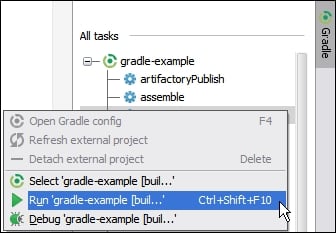

You can also create a Gradle project and store it in the WSL environment or open it from the WSL file system.

You can easily create a new Gradle project, open and sync an existing one, work with several linked projects simultaneously, and manage them. Now that we know where the dependencies should be declared for a Gradle project, let's look at how to add or update dependencies. IntelliJ IDEA supports a fully-functional integration with Gradle that helps you automate your building process. In order for Gradle to run JUnit 5 tests, the test section of the adle file needs to say useJUnitPlatform, so IntelliJ IDEA has generated this for us too. Postpone the initial dependencies downloading to the setupDependencies task which is run in the afterSync phase or by individual tasks. Move intellij.ideaDependency to the SetupDependenciesTask.idea. AI-2021.2.1.4) Make intellij.version property mandatory. It also uses the compact form for dependency declaration, with the group name, artifact name and version number separated by colons. IntelliJ Plugin Verifier allows for running against Android Studio (i.e. Note that IntelliJ IDEA uses the updated configuration names for the dependencies, for example testImplementation instead of testCompile. We also have junit-jupiter-engine, since we need this to run any JUnit 5 tests that we write. We have JUnit 5, specifically 5.7 at the time of recording, set up as a test dependency. IntelliJ IDEA has set us up with a couple of default dependencies that we probably need for the project. We're using Maven Central as the default dependency repository. The metadata underneath this is the group and version information that we left as the defaults. Optionally, select Auto Import on the next screen to automatically import new dependencies. In the plugins section we have the java plugin. When importing an existing Gradle project (one with a adle) into IntelliJ IDEA, when presented with the following screen, select Import from external model-> Gradle.


 0 kommentar(er)
0 kommentar(er)
